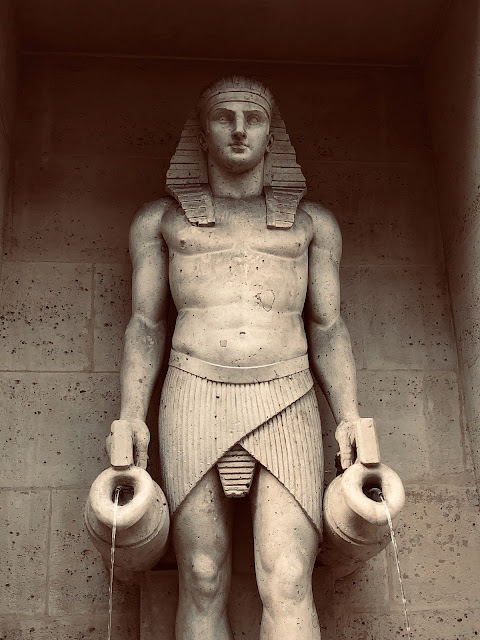 |
| Fontaine du Fellah (1806), 7th Arr. |
Napoleon Bonaparte's conquest (and looting) of Egypt set off a flurry of interest in the arts and culture of ancient civilizations that thrived along the Nile. The design motifs that made it back to Europe were of course a pastiche, jamming together different epochs and dynasties of the region that now includes both Egypt and Sudan. The pastiche approach is understandable. By the time Alexander III of Macedon conquered the region around 330 BCE, there had been about 3,000 thousand years of pharaonic rule, very little of which would be interpretable to the West until after the discovery of the Rosetta Stone by French scholars in 1799.
But Egyptian motifs show up in quite a few places in Paris, such as the Fontaine du Fellah (1806) near the Vaneau metro station. Despite the name (which connotes "peasant fountain") the fountain is based on statues of Osiris, Egypt's ruler of the dead. You can also find sphinxes around town, including adorning Napoleon I's throne in the Salle du Trône (throne room) of the Palais de Luxembourg where France's Senate meets--although these sphinxes are more Greek than Egyptian, perhaps to conjure Alexander's rule as the first Hellenic pharaoh and Napoleon's aspirations to reconstitute the line. In the same room, another pharaoh's image peeks from behind a statue of winged victory. I.M. Pei's glass and metal Pyramide du Louvre pays homage to the museum's extensive collection of Egyptian antiquities. And, of course, Ramesses II's Luxor obelisk (circa 1250 BCE), gifted to France by Ottoman ruler Pasha Muhammad Ali in 1830, stands within the huge traffic circle at Place de la Concorde.
 |
| Egyptian decor in the Salle du Trône of le Senat (Palais du Luxembourg), 6th Arr. |
 |
| Place du Châtelet, 1st Arr. |
 |
| The Luxor obelisk (circa 1250 BCE), seen at left, is technically the oldest monument in Paris. Place de la Concorde, 8th. Arr. |
 |
| Background, I.M. Pei's pyramid at the entrance of the Louvre. Foreground: too hot for a dog. |
Although Great Britain's victory at Alexandria in 1801 ended French dominion over Egypt (the Rosetta Stone ended up in the British Museum in London as war booty), France's association with Egypt remained strong into the 20th century. French scholars administered Egypt's major museums and sites of antiquities until the 1950s. Egyptologist Christiane Desroches-Noblecourt--one of the museum curators who safeguarded the Louvre's holdings from being looted by Nazi occupiers during WWII--led the 22-year effort to disassemble, move, and reassemble the massive temple complex of Abu Simbel out of the flood zone that would be created by the construction of the Aswan High Dam. Getting funding and political commitment from the French government was tricky. Preparations began just a few years after the humiliation of the Suez Crisis, and DeGaulle himself personally berated Deroches-Noblecourt for committing French support without his permission. In turn, she reminded him that during the war he did not seek the government's permission to continue the fight against Germany.
This response won over the General, who approved France's financial and political commitment. André Malraux, who as Foreign Affairs Minister championed Deroches-Noblecourt's efforts to save Abu Simbel, was perhaps awarded a more permanent memento of Franco-Egyptian relations. His tomb in the Pantheon is guarded by an Egyptian cat statue.
 |
| An Egyptian cat stands sentinel at André Malraux's tomb in the Pantheon. |
What does any of this have to do with Halloween? In principle, absolutely nothing.
Various western esoteric groups have sought to link their spiritual lineage to ancient Egyptian mysticism. This was particularly true of Rosicrucianism, a spiritual movement dating back (maybe) to the 1600s. Now organized along the lines of freemasonry and other fraternal orders, the San Jose lodge drove home the association conspicuously with the 1928 construction of their "Rosicrucian Egyptian Oriental Museum."
 |
| Grandma and Emile, 1946, Rosicrucian Egyptian Museum, San Jose, CA. |
But it is still quite a leap from philosophy to horror. As Great Britain intensified its Egyptian and Sudanese occupation in the 1880s, Egyptian magic and mummies began to emerge as horror elements in popular culture--most notably
She (1886) by H. Rider Haggard, "Lot 249" (1889) by Arthur Conan Doyle, and
The Jewel of the Seven Stars (1903) by Bram Stoker. As Roger Luckhurst's
The Mummy's Curse reminds us, the West's association of Egypt with curses did not really take hold of the popular imagination until a
Times of London reporter invented it whole cloth in a fit of pique at not receiving exclusive rights to the discovery of Tutankhamun's tomb in 1922. The curse myth stuck despite the fact that some of the deceased associated with the expedition did not die for decades after the tomb's opening.
But it was probably the 1932 Universal horror film The Mummy starring Boris Karloff--and its syndication as part of the Shock Theater package of classic films licensed for TV in the 1950s--that cemented together Egypt and frights for subsequent generations of Americans. And while I don't feel great about essentializing a 3,200 year civilization to colonialist pulp fantasies and one presumably spectacular piece of hack journalism, depictions of ancient Egypt instantly take me back (at least momentarily) to Bob Wilkins showing The Mummy or any of its numerous sequels and remakes on "Creature Features." I can certainly appreciate the work of legitimate Egyptologists to describe everyday life in the Nile region three millennia ago (and in Desroches-Noblecourt's case, to emphasize to the West that people still have everyday lives in Egypt) and to look for parallels between the ancient political and religious structures of those times and our own. But as soon as I contemplate the months that Desroches-Noblecourt spent in narrow, candlelit passageways transcribing hieroglyphs that describe some jackal-headed or crocodile god's descent into the next world ... I have to admit, it's Karloff for me from that point on.
 |
| Look out! Mummy! |












Comments
Post a Comment